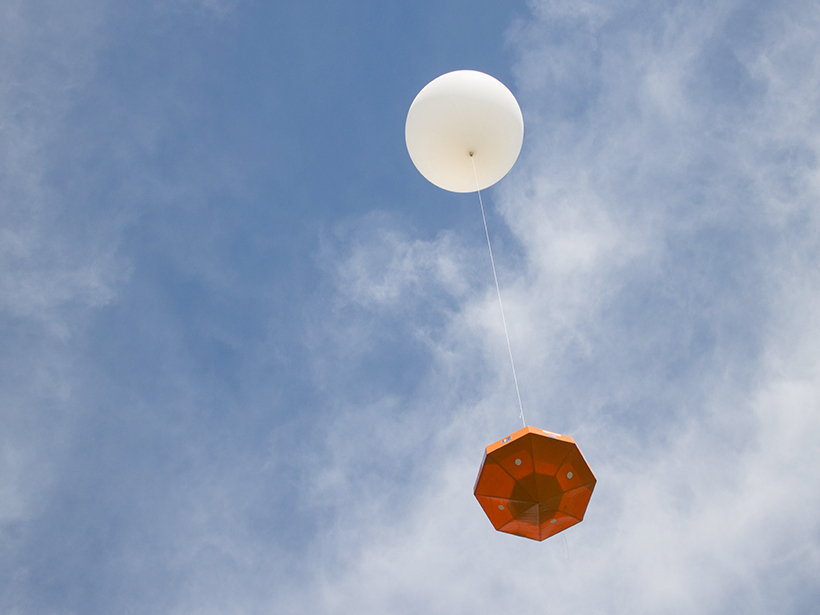Students from three New Hampshire high schools gathered on a soccer field at midnight. After months of working together to prepare a payload for a flight to the edge of Earth’s atmosphere, just into space, their launch vehicle was ready.
The payload had been tested and retested. The flashing strobe beneath the payload—required so that aircraft can see the balloon—was lit. The countdown reached zero, and their high-altitude balloon, carrying a payload of cameras and instruments, began its journey to 30,000 meters above Earth.
The high-altitude balloon, carrying a payload of cameras and instruments, began its journey to 30,000 meters above Earth.
During the balloon’s flight, the student-designed instruments would measure cosmic radiation. At its zenith, cameras would attempt to capture an image of the Earth’s light at night.
However, at 500 meters, the payload broke free of its balloon, fell to Earth, and landed in a lake across the street from the launch site.
“Good! Now they get to see that we learn from our mistakes,” said a school board member who watched the failure. Indeed, back to the drawing board for the students; 2 months later, the system launched successfully.
Both launches were part of an outgrowth of a summer research program involving high school students and teachers at the University of New Hampshire (UNH). For 25 years, UNH has run a summer residential outreach program for high school students called Project SMART (Science and Math Advancement through Research Training).
Students in Project SMART choose one of three separate modules for their summer experience: biotech and nanotechnology, marine and environmental science, or space science. Here we report on strategies used and successes from the space science module.
An Overview of Project SMART
UNH’s SMART Space Science module involves two phrases. First, three local high school physics teachers join with university faculty to welcome roughly 14 students from around the world who attend UNH for a monthlong summer school program. There, students learn core space science and astrophysics ideas while developing new skills and getting what is often their first insight into what careers in science are really like.
Students learn core space science and astrophysics ideas while developing new skills, getting what is often their first insight into careers in science.
In the mornings, the students attend lectures in advanced high school and early college physics and demonstrations provided by the teachers, as well as seminars provided by UNH faculty. They also receive instruction in building and manipulating electronic circuits. The work culminates in the launch of a high-altitude balloon that carries the student-built instruments into the stratosphere.
In the afternoons the students work with UNH professors using real spacecraft data and hardware. They do genuine research and often investigate ideas the faculty are considering—this early work can often open a subject for future efforts by the faculty.
The second phase occurs during the school year. The three high school teachers involved in SMART bring the summer lessons back to their schools to give their students extra experience, beyond what their curricula require. For example, students work with circuits, study cosmic rays, explore principles of thermodynamics, and develop hardware for their own balloon launch. By the end of the school year, all the high school students gather for their own balloon launch.
Approximately 70 students have participated in the Project SMART Space Science module during summers at UNH since 2010. The outreach program to the local high schools has involved more than 200 students in engineering and science projects.
About one third of the participants in the SMART summer program are women, and one third are minorities. The percentage of young women participants increases dramatically when we include the participation at the local high schools. The addition of international students further energizes the program.
Readying Balloons for Launch
Constructing a scientific payload for a high-altitude balloon flight has been Project SMART’s summer team project for the past 9 years.
The balloon program is a direct outcome of an earlier program at Timberlane Regional High School (Plaistow, N.H.) that combined mathematics and physics in the school curriculum. The payload contains cameras as well as instruments built by the students: for example, a Geiger counter, a Sun sensor, an Earth-imaging spectrometer that ranges from the infrared to the ultraviolet, and flight control circuits.
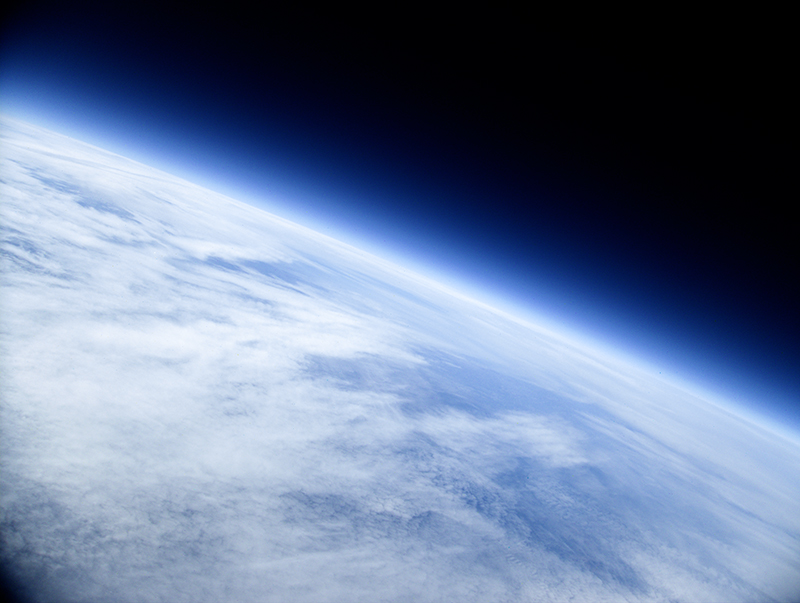
Science motivates our balloon flights, and we always include at least one camera. For still photographs, the Canon company provides a large set of “hacks” for its cameras that enable the students to program the camera to function during the entire flight. Photographs from 30,000 meters (Figure 1) never cease to amaze.
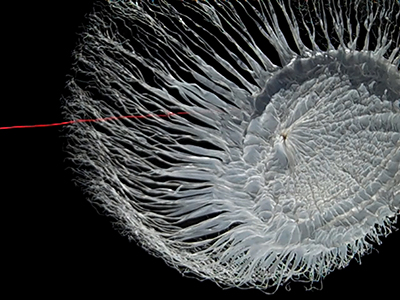
During the flight, instruments send a signal when the onboard GPS reports that the balloon has crossed the preset flight boundaries. A nichrome wire cuts the line to the balloon, thereby dropping the payload. An inexpensive Flip camera records video images, which include capturing the moment when the balloon ruptures (Figure 2).
Designing Instruments
We attempt to refine or initiate new science with each balloon flight. This has driven a program of unanticipated problem solving that lies at the heart of the student experience.
For instance, early in the program, onboard video revealed that the payload tumbles when the balloon bursts at altitude. This tumbling wrapped the parachute around the payload, so that the payload went into free fall.
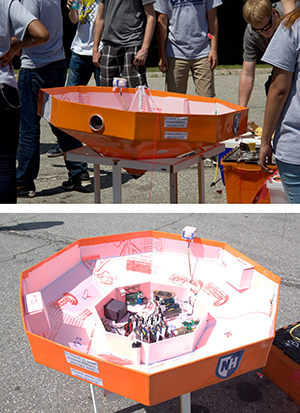
To solve the problem, students at Timberlane Regional High School employed a wind tunnel that they built and experimented with different designs until arriving at the current flight concept that does not require a parachute (Figure 3). When the payload is properly balanced, it descends with very little rotation and remains upright. Students at Coe-Brown Northwood Academy (Northwood, N.H.) optimized the final shape and refined the construction using rigid pink insulation and a model airplane covering called Econokote.
Our students now build their own instruments and data collection circuits using Propeller brand microcontrollers made by Parallax. Students at Londonderry High School built and programmed the first microcontrollers to include programmable flight command functions (Figure 4).
We now use the free online program habhub to set our launch location, determine our flight path, and predict our touchdown point. In total, our balloon flights last from 90 to 120 minutes.
Original Research
In the summer program’s afternoons, the students work with faculty members and their research groups on projects that are accessible to young people. High school students are particularly adept at pattern recognition. They can examine libraries of plots such as spectrograms and look for events with specific characteristics, extract data and build a database of these events, and then use spreadsheets to process the information.

Recent students have used data from NASA’s Advanced Composition Explorer (ACE), Interstellar Boundary Explorer (IBEX), Magnetospheric Multiscale (MMS), Radiation Belt Storm Probes (RBSP), Solar Terrestrial Relations Observatory (STEREO), Wind, and Voyager missions, as well as data from the European Space Agency’s Cluster mission. Recent research topics include coronal mass ejections (Figure 5), electromagnetic ion cyclotron waves, magnetic flux ropes, interplanetary shocks, magnetic reconnection, interstellar pickup ions, radiation belt ion injection, and turbulence. Students have tested prototype hardware, built Helmholtz coils for magnetic calibration, and developed booms for instrument deployment on rockets.

Throughout the process, the students not only learn but also get their first look at real science, to everyone’s benefit. At the end of the month, the students give poster presentations of their research efforts.
Learning as We Go
A common element in all of the projects has been intense student engagement—students have been involved in the design and building of all of these instruments and the supporting circuits.
Three years ago, on the night of the failed launch, the school board member was right—we do learn from our mistakes: The cutaway hardware we used for that flight was picking up our ham radio transmissions and cutting the payload free prematurely.
The students responded by rerouting cables and adding more shielding and twisted pairs to mitigate radio frequency interference for all electronics. Likewise, once the GPS reports that the payload is descending, the autonomous onboard software now sends the same signal to cut away the remains of the balloon so that the payload flies in a more stable configuration.
Watch the successful launch:

Other launch videos from 2009 onward can be found on our YouTube channel.
Our use of sensors continues to evolve. Students now build Sun direction sensors using cadmium sulfide photoresistors and ping-pong ball diffusers [Verhage, 2010a, 2010b]. They build prototype light-emitting diode–based spectrometer multispectrum light sensors that look at light reflected from Earth [Mims, 1992]. We are also considering adding a lightweight dust collector that may be used to collect particulates and high-altitude organic matter in the future. We also have designs for a momentum wheel that will provide greater pointing accuracy to photograph less intense objects such as aurora.
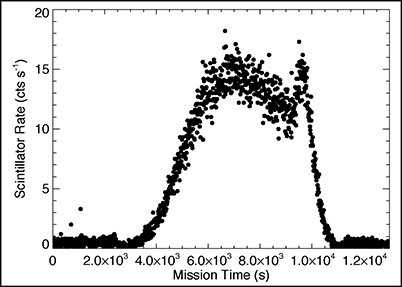
Most recently, the high school team built dedicated electronics that recorded data generated by a gamma ray and energetic neutron detector prototype. This prototype, built by UNH professor Peter Bloser, was successfully flown in November 2015 (Figure 6). High school students are now building more advanced electronics that will provide energy spectra of the cosmic rays they measure.
All this work not only provides students with engineering and mission experience but also helps generate scientific baselines. The successful demonstration of operation in the near-space environment of the balloon flight is quite valuable for future proposals to NASA that will seek to fly similar detector technology on space missions.
A Model for Other Groups
During the failed launch 4 years ago, one of our students—a young woman at Londonderry—was instrumental in building the flight computer. Her plan was to go into communications after high school.
She is now into her fourth year as an electrical engineering student at UNH and spends her spare time in a lab, building parts for suborbital rockets. We count her as one of our success stories.
We welcome other groups to follow the model for the Space Science module of Project SMART. We are not the first to use high-altitude ballooning as a tool to engage high school students with different approaches to common problems [Verhage, 2015]. The key to our efforts is to have an active faculty that asks more of students than many think possible while engaging the talents and imagination of local high school teachers and creating opportunities for authentic scientific experiences.
We seek to foster experiences that serve students in their future, whatever their career paths.
We recognize that not every student goes on to a career in science or engineering. Many do, but that is not the only goal of this effort.
We wish to give motivated students the opportunity to learn that the pursuit of knowledge does not begin or end in the classroom. We seek to foster experiences that serve students in their future, whatever their career paths. And, of course, we hope they emerge from the program inclined toward careers in science and engineering.
Acknowledgments
We thank the many professors at UNH who regularly contribute to and mentor students in the program.
References
Mims, F. (1992), Sun photometer with light-emitting diodes as spectrally selective detectors, Appl. Opt., 31, 6965.
Verhage, L. P. (2010a), Sun sensor for data collection, Nuts Volts, March, 67.
Verhage, L. P. (2010b), Testing the complete NearSys Sun sensor, Nuts Volts, May, 67.
Verhage, L. P. (2015), Showing teachers one way to incorporate near space, Nuts Volts, December, 46.
Author Information
Charles W. Smith, Peter F. Bloser, and Noe Lugaz, Space Science Center, Institute for the Study of Earth, Oceans, and Space, University of New Hampshire, Durham; email: [email protected]; Louis Broad, Timberlane Regional High School, Plaistow, N.H.; Scott Goelzer, Coe-Brown Northwood Academy, Northwood, N.H.; and Richard A. Levergood, Londonderry High School, Londonderry, N.H.
Citation:
Smith, C. W.,Bloser, P. F.,Lugaz, N.,Broad, L.,Goelzer, S., and Levergood, R. A. (2016), Balloon launches introduce students to space science, Eos, 97, https://doi.org/10.1029/2016EO061101. Published on 18 October 2016.
Text © 2016. The authors. CC BY-NC-ND 3.0
Except where otherwise noted, images are subject to copyright. Any reuse without express permission from the copyright owner is prohibited.

